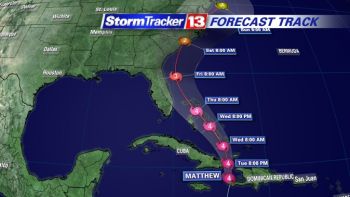
04 Oct Storm Damage & Hurricane Preparedness – Matthew Update
Known for our severe weather, Florida has more thunderstorm activity than any other part of the nation. With temperatures regularly climbing well into the 90’s, we have already seen some of our typical extremes this year. Hail and wind-driven rain – not to mention the tropical storm and hurricane-force winds that storms like Hurricane Matthew can bring – all unite to deliver exiting tempests that can cause severe damage to unprepared homes.
Your roof is your home’s first line of defense against the onslaught of extreme weather. Normal aging and past storms may have already resulted in damage that has left your home and family unprotected. When you look at your roof, consider the signs; cracked, blistered, curling or missing shingles are all causes for concern. However, it is unlikely that homeowners – or even home inspectors – are able to identify with confidence all your existing storm damage. Here are some commonly missed identifiers that an experienced roofing contractor will look for when performing an exterior evaluation.
- Torn, lifted, and creased shingles are a common result of wind damage. Circular areas of missing granules, bruising, and spawling resulting from hail may be overlooked if not viewed by a properly trained eye.
- Flashing problems like pinhole leaks and rust are common indicators of aging, damage and water intrusion.
- Penetration issues like damage around skylights, vents and plumbing access are very common and often overlooked. A well-trained eye is necessary to spot worn or missing caulking or sealants.
- Chimney leaks are another common roofing problem. Surface deterioration or damage to the chimney cap or flashing will create vulnerable areas where leaks will likely occur.
- An exterior inspection will also include a thorough evaluation of your siding materials and windows for dents and splatter marks. Mullions are the vertical dividers between the sections of your windows, and are where visible dents may result from hailstone impact. When soft hailstones or slosh balls strike, they leave splatter marks on exterior surfaces and can indicate other areas of damage.
These are all signs of aging or storm damage that if left unattended, could result in water intrusion and unnecessary costly repairs.
June 1st marked the beginning of the 2016 Atlantic hurricane season, and we have already seen a number of tropical storms and severe weather systems. Hurricane season lasts until November 30th, and according to FSU’s Florida Climate Center, the peak of hurricane season occurs between mid-August and late October. This week, Hurricane Matthew threatens to bring gale-force winds, wind-driven rain and lots of precipitation to Florida homes.
According to the Hurricane Center at News 13: “Models are starting to converge on a path near our east coast by Thursday night. This could mean a higher threat for tropical-storm-force winds into southeast Florida by Thursday afternoon. Tropical-storm-force winds spread up the coast late evening Thursday, with hurricane-force winds possible along the Brevard County and Volusia County coast overnight. Any shift west will spread hurricane-force winds inland. We’re also looking at squalls of heavy rain and serious wave action along the east coast Thursday night and Friday. Wave heights could be close to 20 feet just off-shore of Cape Canaveral as the storm nears.”
Here are some things to consider in preparing your family for severe weather.
- Take a look at your trees and landscaping. Dead or rotten branches and shrubs can turn into volatile projectiles when loosened by strong wind gusts. Hire a tree service or arborist to remove dead limbs and thin out trees; this will allow wind to pass through trees rather than creating breakage and flying debris. Store lawn furniture and other yard accessories indoors while not in use.
- Closely examine the exterior of your home and protect it from wind-driven rain and water intrusion. Seal and caulk all cracks in stucco, seal with good quality paint, and properly install high-grade windows to ensure a tight perimeter. A good contractor can perform this type of inspection and make necessary repairs.
- It is always a good idea to prepare a family emergency plan. Assemble medical and emergency kits, and stock up on water and non-perishable foods. You can visit FEMA’s ready.gov and redcross.org for valuable preparedness tips and local agencies and evacuation routes. Also, consider storing important documents and paperwork; this will make for easy access if needed.
- Call a licensed roofing contractor to fully inspect your roof and home perimeter. Regular yearly inspections by a state-licensed roofing professional are highly recommended. The repair of damage found early costs much less than a major roof repair or replacement and will prevent the need for expensive interior reconstruction.
Call upon the professionals at Universal Roof & Contracting. Since 1993, we have been helping our greater Orlando neighbors recover from severe weather. Our experienced estimators are specially trained to detect storm damage. During our Free Severe Weather Home Evaluation, our experts will scrutinize your roof and entire home exterior. We will help you detect vulnerable areas that can leave you unprotected against water intrusion, wood rot and mold infestation. Many roofing companies follow the storms, but Universal Roof & Contracting is committed to securing Florida homes here in our own community. We will help you restore and fortify your roof and exterior before and after the storm, advising you every step of the way. Call us now to schedule your Free Severe Weather Home Evaluation. Orlando: 407-295-7403 Jacksonville: 904-647-3907



